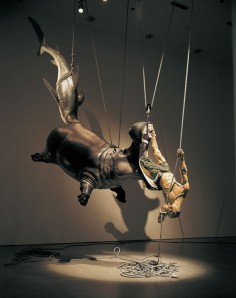CHEN WENLING
Чен Венлинг
陈文令
陳嶺
the suspense

source: sitedooriente
Chen Wenling nasceu em 1969 em Fujian, China. Ele estudou na Academia de Xiamen de Arte e Design, e na Academia Central de Belas Artes de Pequim. Chen atualmente vive e trabalha em Pequim como artista profissional.
Chen Wenling é reconhecido como um dos dez maiores escultores contemporâneos da China de hoje.
Olhando para as obras, podemos notar uma clara crítica ao capitalismo selvagem e a sociedade de consumo, que é a imagem da sociedade chinesa atual.
.
.
.
.
.
.
.
source: elitedaily
Chen Wenling was born in 1969 in Anxi, Fujian China. He studied at the Xiamen Academy of Art and Design, and at the Central Academy of Fine Arts in Beijing. He is now living and working in Xiamen and Beijing as a professional artist.
.
.
.
.
.
.
.
source: actuartorg
Chen Wenling est un jeune sculpteur célèbre travaillant et vivant à Xiamen, dans la province Chinoise de Fujian.
Le travail de série de Chen sur des Garçons Rouges, ayant droit à la Mémoire du Rouge Chinois, qui a des significations diverses pour des visiteurs amateur d’art moderne. Ils peuvent faire le rapprochement sur la sinification du Garçon Rouge d’un des quatre grands romans chinois le Roi d’Argent. Il peuvent aussi rappeler les Gardes Rouges pendant la Révolution culturelle, avec un sentiment de naîveté et de cruauté.
Chen Wenling est un artiste de laïcisme et en même temps il utilise dans sa sculpture une façon pleine d’humour et provocatrice, une mise en scène maitrisée et éxagérée des thèmes divers (l’amour, l’histoire, la tradition, l’occident…).
Concernant la série du porc, elle représente une véritable signature dans le travail de Chen Wenling et en même temps le porc est un animal spécial pour des Chinois. Aucun peuple dans des autres pays ne sont ainsi près des porcs, le porc, en fait, est la Chine elle-même.
Particulièrement dans Fujian, Guangdong et Guangxi, “la culture de porc” est très populaire. Comme un proverbe Chinois le dit “un homme né , vie et meurt toujours avec de son porc”.
L’art moderne souligne les concepts. Il crée souvent un style avec trop de concepts, faisant des observateurs (téléspectateurs) fatigués. Au contraire, les œuvres de Chen sont simples, surprenantes et vraies. Il ne crée pas délibérément de concepts. Les corps nus n’ont rien pour se déguiser. Ce qui est parti est une communication directe avec la nature et une conversation directe entre la société et les gens. Le soin des visages et les expressions de corps des Garçons Rouges sont correctement exagérés pour augmenter les effets communicatifs.
.
.
.
.
.
.
.
source: encafacomcn
Recognized as one of the top contemporary sculptors in China today, Chen Wenling has participated in a number of prestigious exhibitions, such as Art Basel in Switzerland and the Shanghai Biennale. Chen Wenling says he was a playful child, “always monkeying around” and he wants to “challenge the extremes in both work and life.”
Born in 1969 in a poor family at Anxi, a small, remote village in Fujian province, China, Chen remembers growing making figurines out of clay to entertain himself, yet he counts himself lucky because his parents encouraged his artistic talent. Chen spent his formative years at the Xiamen Academy of Art and Design, and then at the Central Academy of Fine Arts in Beijing.
The two main themes of Chen Wenling’s sculptures are the manifestations of extreme humanity and immaterial images in a consumption society. He shot to artistic fame with his Red Memory series (2001-07): more than 100 outsized figures of naked boys while at play, all covered in shiny red car duco. While the red boys (a colloquial expression for newborn sons) were bursting with innocent fun, Chen Wenling’s focus has since shifted to adults and their vices. It is neither realism nor vanguard sculpture, but the self expression of Chen Wenling himself on the critical state of life.
Many of his more recent works involve pigs, which he finds a perfect metaphor for Chinese people today. In Chinese tradition, he says, pigs are seen as “gluttonous, lazy, dirty, horny and stupid as well as content and happy, while science has shown that pigs are very clever. In my eyes, the pig also symbolises speed … and enormous productivity.” Chen Wenling depicts pigs as human and humans as pigs, interdependent almost to the point of fusion. In terms of artistic language, Chen Wenling’s recent artworks are closer to a type of surrealistic legendary language while his recent series blurs the directness of the social metaphor, but is inclined to reveal the preposterous being of the self.
.
.
.
.
.
.
.
source: becreativeordie
Chen Wenling es reconocido como uno de los escultores contemporáneos top ten en la China actual. Vamos a repasar alguna de sus obras y un poco de su historia, los dejo con el arte de Chen.
Nació en 1969 en un pequeño pueblo de la provincia de Fujian en China, Chen recuerda que debido a que sus padres no podían comprarle juguetes el se entretenía creando figuritas de barro.
Chen tiene entre sus influencias a Rodin, así como Picasso, Magritte, Dalí y el escultor colombiano Botero. Los dos principales temas de sus esculturas son las manifestaciones extremas de la humanidad y las imágenes inmateriales en una sociedad de consumo.
.
.
.
.
.
.
.
source: blogseriusblogspot
Chen Wenling ialah antara artis yang sedang menampa nama dipersada seni arca dunia. Dilahirkan di China, Chen yerkenal dengan arca sitarical beliau yang bukan sahaja aneh tetapi penuh dengan mesej sinis. Genius!
.
.
.
.
.
.
.
source: personalklavdievnaru
Чен Венлинг (Chen Wenling), скульптор из Китая , взлёт популярности которого стал стремительным в последние 5 лет, известен своими эпатажными работами.
.
.
.
.
.
.
.
source: chinanews
用现实追问创作本质
陈文令的创作来源于现实,他把个人意识转化为公众认知,是他所坚持的艺术理念。展览的另一件作品《悬案》中,一个人抓住一根绳子,试图通过滑轮捕获了鲨鱼,鲨鱼咬住河马,河马又攻击鳄鱼,在鳄鱼的口中还有一个人在挣扎。陈文令解释道,这都是很凶残的动物,人类是其中之最。《悬案》这件作品,陈文令认为他只是在陈述人类的某种困境,以牙还牙,以暴制暴,攻击与被攻击。在这个食物链中,谁都是胜利者又是失败者。“《悬案》这个作品,我只是提出了一个残酷的现实问题,而答案宽恕就在我回访歹徒的行为中。”
陈文令的作品因为暴力、色情曾受到舆论质疑。之前,扭捏作态的“猪”系列作品中,陈文令解释,他是想用以毒攻毒的方式表现社会的庸俗。这套作品的起因是陈文令在《厦门晚报》的一篇报道中得知,一只母猪一口气生了28只小猪。怀揣着好奇,陈文令去追寻这只母猪。他发现,猪的生产就像一个工厂,和今天的世界很应和,它的贪婪、好色、懒惰,跟人性又有着相通之处。“猪的物质,用很优雅的创作形式说明不了问题。”陈文令觉得需要用夸张的手法去强调。黑色幽默带着人性温暖,这是陈文令作品给人最深刻的印象。陈文令认为:“社会道义和人类良心是艺术家必须承担的责任。”关注现实,但不是表面,陈文令强调:“我不是一个写生艺术家。”
用朴素体会幸福感
陈文令坦言用“确信”二字让自己跟自己死磕,这是他对工作的态度;但是对于生活,他却保持着“无所谓”的平和。生活中的陈文令是一个非常容易满足的人,他自称对幸福的沸点非常低。他回忆,性格的改变也来源于16年的生死劫。“我的命是捡回来的,让我重新活一次,我非常珍惜。”
经过去年去歹徒家的回访,陈文令更不断地追问自己,人经历什么样的苦难还能活着?想到这一点,陈文令笑起来:“这个问题可能就没有底线了。”陈文令认为人生不必太多抱怨,极其简单、极其智慧的快乐生活就是他所坚持的朴素美学。
为此,他讲了一个小故事。“我很喜欢跑步,这可能是我创作之外最大的爱好。”去年10月在望京公园,跑了一个多月。由于修建人工湖泊,地被挖得乱七八糟。陈文令无奈只有退到小区里跑步。他一边讲着一边微笑道:“虽然小区不如公园那么抒情,但也算惬意。”直至12月寒冬,空气太冷了,灰尘也太大,陈文令只有回到家中跑步。“虽然跑道短一点,但我也会绕着弯儿地跑。直到前几天阿姨请假,我的小女儿把玩具堆一地挡住了我的跑道。”但陈文令却发现小小的阻挡带来了生机,遇到玩具就跳一下,也能弄得自己很开心。陈文令设想,就算哪一天又多了更多的阻碍,原地跑步他都同样会找到乐趣。陈文令笑道:“我看待生活就是如此简单。”
伤指的艺术世界
采访过程中,当陈文令讲到身中20多刀时,他伸出双手告诉我:“我左手的食指、中指、无名指和右手的食指都受过伤。现在末梢关节也不能动。”说着他试着弯曲却无能为力的手指。我惊奇地发现,有4根手指没有皱纹,触碰的时候,也没有任何感觉。
手指受伤对于一个雕塑家来讲何其痛苦。陈文令当时连写字都困难,曾一度绝望。但是他相信人的一生中,不幸的背后,隐藏着另一种可行性。上帝关上一道门,也自然会为你开启一扇窗。于是,他放弃了雕塑表面肌理的处理,用刮刀制造出光滑的效果。这才有了陈文令最早的成名作“小红人”的诞生。

